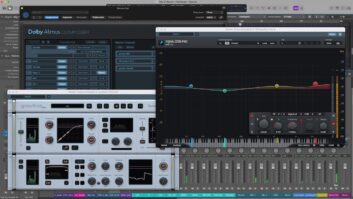
Concluding our coverage of the four-year Iron Maiden ‘Legacy of the Beast’ tour, FOH engineer Ken “Pooch” Van Druten shares how he approaches each instrument in the mix, the band’s monitor system, what’s in store for the upcoming Future Past tour and more. Don’t miss Part 1, where he discusses key plug-ins, outboard gear, mix tips and more!
Bringing all that gear to bear on the mix meant Pooch could focus in on the details of the songs. “They’re super-nuanced, and that’s what makes this band sound great, so I use the digital console with all its snapshot technology to get into those moments,” he says. “For instance, one of the tough parts about mixing them is that there’s three guitar players that all play Fenders through Marshalls, so there’s somewhat similar tones and they’re certainly in the same frequency range; finding space so that you can pick them out individually in the mix is difficult. My solution was to put them in their own panning spaces based on where they are on stage. Dave Murray is on stage right, so he’s panned stage right—not panned hard all the way, but he’s over there—while Adrian Smith is near the center, and Janick Gers is on stage left. It’s big, wide, spread out, and you can pick out every single guitar—but then I also had to build snapshots so that whenever one of the guitarists solos, it snaps to the center, they play it, and then the next snapshot gets them back to their spot. It’s those kinds of nuances that make a difference.”
To capture those guitar sounds, each guitar player had three inputs, comprised of usual-suspect microphones like Shure 57s and a Palmer PDI-09 Junction Guitar Direct box, which captured sound after the effects and preamps, plus it picked up the warmth of the guitar amp itself.

Of course, as Iron Maiden fans will note, there was another crucial guitar sound that had to be extremely present in the mix: the bass of Steve Harris. “His bass tone is very different than anybody else out there; it’s almost like a fourth guitar, because it doesn’t have a whole lot of low end in it,” Pooch concedes. “If you listen to any Iron Maiden record, vocals are the loudest element, and the next loudest thing is the bass guitar. He has a signature sound that you can’t capture with a DI; we use an SM7 on his cabinet, and that is the sound of Steve Harris.”
Meanwhile, Nicko McBrain’s drum sound was captured with a slew of mics, starting with a Randall May system inside the kick drum, used to support both a Shure Beta51 and a SM91 boundary mic to get some of the shell sound. Nearby, the snare was heard via a Shure SM57 on bottom and a Telefunken M80-SH on top, chosen in part for its bump in the high-end to better capture the crack of the snare. The hi-hat cymbal sported a DPA 2011C, while the ride cymbal got a Mojave Audio MA-201fetVG LDC; that same model was used for overheads as well.

Nonetheless, much of the drum kit real estate was taken up by no less than nine toms, each with its own DPA d:vote 4099 CORE mic, except for the 6-inch and 8-inch which shared one. Faced with so many open microphones on the toms, Pooch notes, “I’m triggering gates, but rather than the gate getting its threshold information from the audio signal, it comes from a trigger that is affixed on the side of each drum shell.”
Over in the Iron Maiden Monitorworld sat a pair of DiGiCo SD desks; there, longtime monitor engineer Steve “Gonzo” Smith looked after Harris’ mix, while the rest of the band was under the watchful eye of Kevin “Tater” McCarthy. While all three guitarists sported in-ear monitors, there was still plenty of sound covering the stage—McBrain had his own giant, custom wedge and sub for monitoring, while both Dickinson and Harris preferred to get their mixes from a vast assortment of speakers. Intriguingly, there were two sets of side fills, with one operated by each monitor engineer; Harris’ sidefills were old-school Turbosound TMS3s, supplemented downstage by three sets of the band’s own custom wedges, dating back to the 1980s. Meanwhile, Dickinson preferred his own L-Acoustics sidefills further upstage closer to the drum kit, and also heard upward of two-dozen d&b audiotechnik M2 and M4 wedges around the stage.

With the four-year Legacy of the Beast trek now over, one might expect Iron Maiden to take it easy for a few minutes, but the band will get back on the road in May; the 2023-24 Future Past tour will serve as the proper introduction to the new Senjutsu album while also shining a spotlight on the often-underplayed Somewhere in Time from 1986. Already looking forward to it is Pooch, who is still one of the most recent additions to a crew where most personnel have logged decades working for the group. “I am the new kid on the block, having been here for five years,” he laughed. “They are an amazing band to work for; I will stay here for as long as they’ll have me.”







